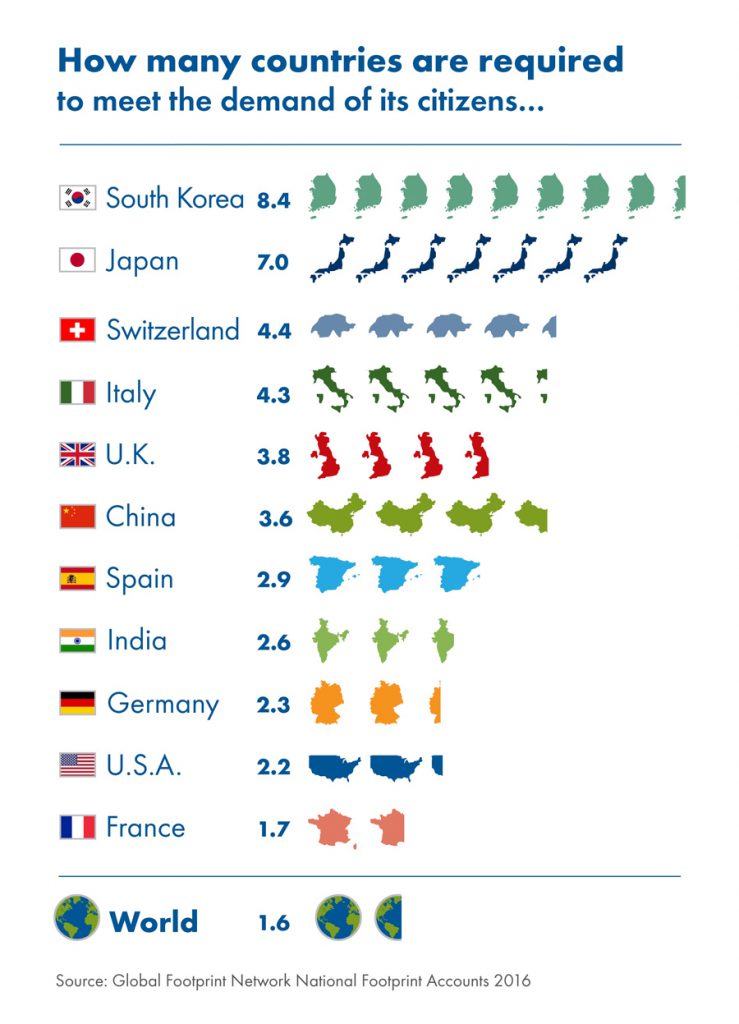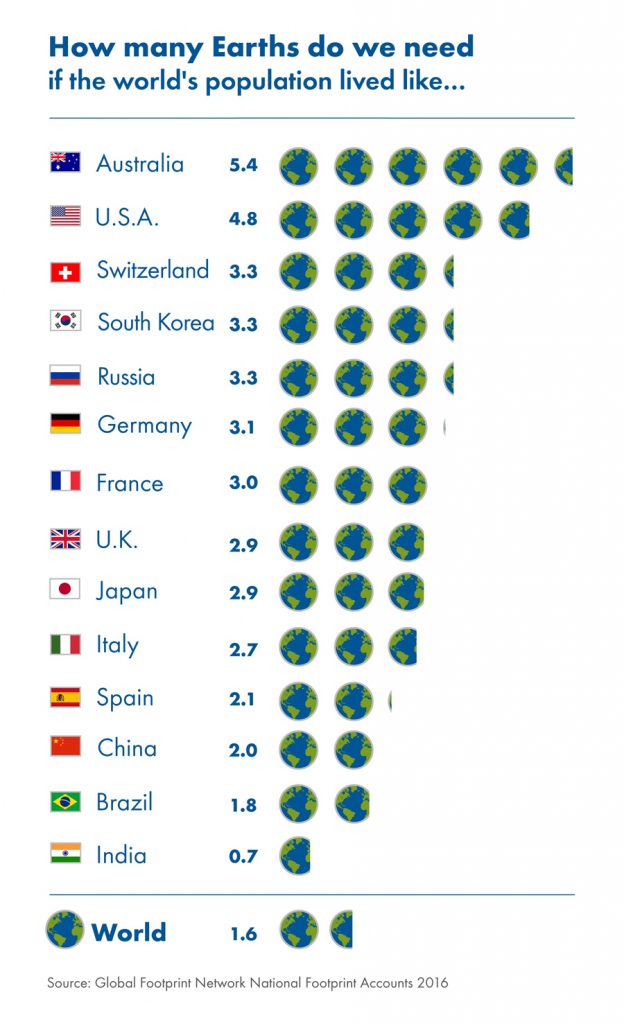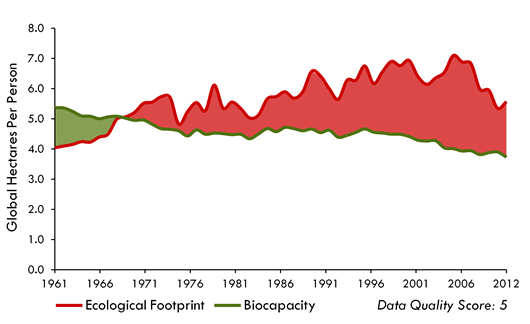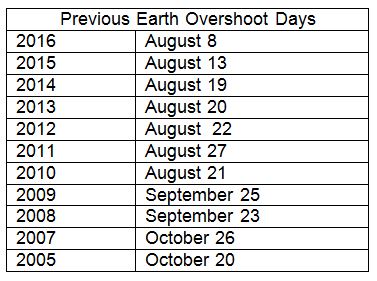It’s early August and the summer break is well and truly underway: schools are closed; politicians take some much needed respite from months of electioneering; an attempted coup in Turkey; the Olympics dominating the front pages of the papers; news on how 2016 is becoming the hottest year on record (since 1880)…and a reminder that for the sixth year in a row humans have exhausted annual supplies and outstripped Earth’s capacity to absorb greenhouse gases in less than eight months.
Today is Earth Overshoot Day: the day when humanity’s demand on nature (such as land, trees and fish) exceeds what earth can regenerate that year.
For the rest of 2016 we will overspend our ecological deficit by drawing down local resource stocks and emitting carbon dioxide into the atmosphere. We will be operating in overshoot.
By and large, a typical August report then.
| Calculating Earth Overshoot Day
The folks at the Global Footprint Network have been calculating the annual environmental budget that the planet can afford since 1988. Earth Overshoot Day is calculated by dividing the world biocapacity (the amount of natural resources generated by Earth that year, such as land, trees and fish), by the world ecological footprint (humanity’s consumption of Earth’s natural resources for that year). This ratio is multiplied by 365 to get the date when Earth Overshoot Day is reached: The calculation looks like this: (Planet’s Biocapacity/Humanity’s Ecological Footprint) x 365 = Earth Overshoot Day Overshoot is driven by four key factors: 1) how much we consume, 2) how efficiently products are made, 3) how many of us there are, and 4) how much nature’s ecosystems are able to produce. Technology and more intensive inputs have helped expand biological productivity over the years, but that expansion has not come close to keeping pace with the rate at which population and resource demand have expanded. |
What are the costs of our overshoot?
We’ve used up all of our ecological resources in 2016 – so where will they manage to come from for the remaining months of the year? What are the costs of our overshoot?
- ecological costs through our natural environment in the form of deforestation, freshwater scarcity, soil erosion, biodiversity loss and the build-up of CO2 in our atmosphere.
- climate change costs due to rising global carbon footprint, linked directly to other environmental costs: cropland, grazing land, forests and productive land built over with buildings and roads. “All these demands compete for space. As more is being demanded for food and timber products, fewer productive areas are available to absorb carbon from fossil fuel. This means carbon emissions accumulate in the atmosphere rather than being fully absorbed.” – Global Footprint Network
- the cost on the poorest in the world: the greatest intensity of poverty around the world is carried by 1.5 billion people in the 101 developing countries (about 30% of country populations) in what the UN Human Development Report calls ‘multidimensional poverty’, experiencing acute deprivations health, education and living standards indicators. Ecological and environmental costs will only exacerbate the lives of people living in extreme and multidimensional poverty who do not have equal access to natural resources (least of all because they may live in a country that has a biocapacity credit):
- non-human species: half of all the world’s wildlife has gone in the last 40 years alone, according to WWF
- the needs of future generations
Two insights that challenge ‘what’ and ‘how’ we consume natural resources
Calculating how much we overspend on an annual basis in terms of what nature can afford in human consumption and production practices reveals two insights that are impossible for us to escape from:
- National accounts demands: can national resources meet the demand of its citizens?

- Global accounts demands: in the league table of ‘overshoot deficit champions’ how planets (of natural resources) would it take if everyone across the world consumed natural resources as much as Australians and Americans (…or Swiss, South Koreans, Russians etc.?

How is this possible?
“This is possible because we emit more carbon dioxide into the atmosphere than our oceans and forests can absorb, and we deplete fisheries and harvest forests more quickly than they can reproduce and regrow.
Carbon emissions are the fastest growing contributor to ecological overshoot, with the carbon Footprint now making up 60% of humanity’s demand on nature, which we call its Ecological Footprint. If we adhere to the goals set by the Paris climate agreement adopted by nearly 200 countries in December 2015, the carbon Footprint will need to gradually fall to zero by 2050. This calls for a new way of living on our one planet”
– Global Footprint Network (12 July 2016)
On Ireland’s climate change targets: the land of slow learners
Ireland’s ecological footprint currently exceeds its biocapacity by 49%:

This should not come as news: the political establishment in Ireland have not taken threats posed by global warming seriously.
‘Special pleading’ for Ireland has been pursued vigorously at the EU and despite Irish pomp and circumstance at the COP 21 Paris Summit, Ireland’s record makes difficult reading: the EU requires a 20pc cut of emissions by 2020 over 2005 levels – on the current pathway, Ireland will have reduced by just 5pc. Official support for Irish agriculture is travelling in the opposite direction: emissions are expected to increase by 2pc by 2020 as Government plans to ramp up food production.
Key pressure group, the Environmental Pillar, are more than sanguine on the new targets for Ireland revised by the EU in July to cover the period 2021-2030:
“Under the proposed targets Ireland will have to reduce emissions in these sectors [agriculture, transport, buildings and waste] by 30 per cent by 2030 – on the basis of an average of 2016 – 2018 emissions. This means that Ireland has been rewarded for not attempting to meet its 2020 targets.”
The Irish Times editorial on 23 July 2016 summarises the sober reality of Ireland’s official position on climate change targets in the land of slow learners:
“As a result, not only has the overall emissions reduction target we need to meet in 2030 been cut from 40 to 30 per cent, but loopholes will allow burgeoning emissions from agriculture and transport to be offset by carbon sequestration and trading. The deal doesn’t even require us to save what’s left of our peatlands, a significant carbon store.
Given that Ireland is on course to breach EU target for 2020, largely due to recidivist inactivity by successive governments to curb emissions, there can be no confidence that we will meet the new 2030 target.”
Act (and learn about) overshoot now, not later
Earth Overshoot is one of those moments that can’t wait until it aligns with the school/college calendar to teach it (many UN and global days of significance are taught on the days that the fall, for example, Human Rights Day on 10 December).
By the time Earth Overshoot Day will align again with term  time for formal education teaching in May, for example, based on present trends, we would have a planetary biocapacity budget of five months to contain 12 month of human consumption and the global goals for Sustainable Development will have expired.
time for formal education teaching in May, for example, based on present trends, we would have a planetary biocapacity budget of five months to contain 12 month of human consumption and the global goals for Sustainable Development will have expired.
As for the next August report we can expect it to look quite different next year: from global (and Irish) consumption and production trends we are on course for Earth Overshoot Day to take us into July in 2017, consuming 12 months of the planets resources in less than 7 months.
Timetabling environmental education, education for sustainable development and action around implementation of a national plan in Ireland for the Sustainable Development Goals cannot wait.
………………………………………………………..
Teaching Earth Overshoot Day: some resources
Overshoot day website: www.overshootday.org
#pledgefortheplanet: campaign managed by the Earth Overshoot Day team, with social media links, graphics and background info
Footprint Calculator: Measure your own Ecological Footprint with an online Footprint calculator (desktop computer required, available in several languages). The calculator tells you how many Earths would be required if everyone on the planet lived like you, and then suggests ways to reduce your Ecological Footprint. footprintcalculator.org
Videos: on the theme of overshoot day, selected by the Global Footprint Network
Learning guide and animations: on the topic of consumption produced by developmenteducation.ie in 2013
Public data package: non-commercial use of the full dataset via Global Footprint Network, includes:
- 2012 Ecological Footprint and biocapacity results for all countries included in National Footprint Accounts 2016
- Graphics of time-trend (1961-2012) Ecological Footprint and biocapacity results for each country
- Global Footprint and biocapacity time series results and graphs (overshoot, layer cake, HDI, and creditor/debtor map)
- List of data quality scores for each country
- Scientific and Editorial Review Policy
Interactive graphic: the Ecological Wealth of Nations infographic (2016) via Global Footprint Network
Footprint Futures, a university-level curriculum (with student-driven approach) for exploring the sustainability challenge facing human economies, from Global Footprint Network.
Trashy Stationary: Don’t trash your trash, when you can recycle it into beautiful cards and stationery! discoverykids.com/activities/trashy-stationery
Student-friendly article on the Ecological Footprint, with link to Footprint calculator for children, from KQED Quest.
Environmental Footprint calculator from WWF-UK. (includes top tips on how to reduce your footprint).


